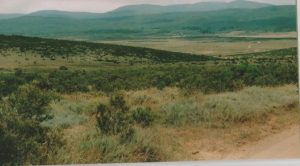Ted Taylor, from Northern KNP is knowledgeable of the background and origins of various Snowy Brumby breed types, from:
- Kiandra
- Yarrangobilly Caves.
- Long Plain/Currango
- Peppercorn, Broken Cart and Brindabella, and
- Coolamine
Below is his account of the history of horses from this area.
Short history of High Plains Wild Horses from Kiandra to Peppercorn
Ted Taylor
“I now describe, for those not privileged to see KNP when leased and grazed by tens of thousands of sheep and cattle for over one 100 yrs. It was a very beautiful healthy landscape; the broad-toothed rat, corroboree frog, fish and wild flowers were in abundance. Weeds and feral animals were controlled by the lessees and were practically non-existent.
The generation that lived to experience the High Country mourn the degradation following the closure of the snow leases but photos will testify to the open plains and woodlands devoid of woody scrub, for example:
Photo-1 Ted Taylor in 1953 Photo-2 same location in 2005
Photo-1: Ted Taylor open plain of Currango (1953) and his Peppercorn Brumby.
Photo-2: 2005 Exactly the same spot as above, Currango Plain.
Gordon Day explains “Brownlee from Yarrangobilly Village (original settler 1880) purchased a grey thoroughbred stallion that he ran with mares at Pidgeon Square. Gordon reports that many grey horses used to run the area that were offspring of that stallion. Franklins of Brindabella brought mares over and joined them with this stallion plus horses were let go to breed up. Apparently there was a bit of friction between Walter Hoad and the Franklins about who owned the horses – but that’s another story.
The grey horses in the Kiandra area are descendants of this breed and owned by George Day; he ran fifteen mares and one well-bred Arab stallion on a lease in the Goandara area. The Days returned each year to collect yearlings until leases closed and fences fell down. George’s son Gordon said “we used to go up to Witzes area and run the mares and yearling into the holding paddock around Witzes and take out what yearlings we wanted and let the mares go, this became very difficult when the fences fell down and it went from rounding up the horse to brumby running!”
The red roans running there at the same time belonged to the Dunn family of Yarrangobilly Caves. This was in the late fifties and sixties. The Snow Leases in the Kiandra area began closing in the early sixties, fences started to deteriorate allowing the horses to spread.
Horses on the Long Plain/Currango area came from the Broken Cart, Peppercorn area, the most distinct being a chestnut with a creamy mane and tail along with brown, black and bay horses. These horses ran in the Peppercorn, Broken Cart and Brindabella in the East and Emu Flat in the North/West from the early gold mining and grazing days, since about 1839 when Terrence Murray abandoned his tired horses at Coolamine. (read Murray of Yarralumbla).
Driving from Rules Point to Currango recently, we were disappointed to see so many horses in one area, enticed by salt in the ground near trap yards. These horses would normally have been in small mobs scattered throughout thousands of hectares of the high country. All animals love salt so wallabies and roos will also dig for residual salt for a long time.
Most visitors feel it is an exhilarating experience to see the Brumbies and photograph them. Another advantage of having grazing animals is keeping the fire fuel down, because there is nothing else to replace them that would make a difference and no burning the plain yearly as the lessees and the Aborigines did before Europeans arrived”.
Ted Taylor 5/1/16 Tumut – Edited 27/7/16







